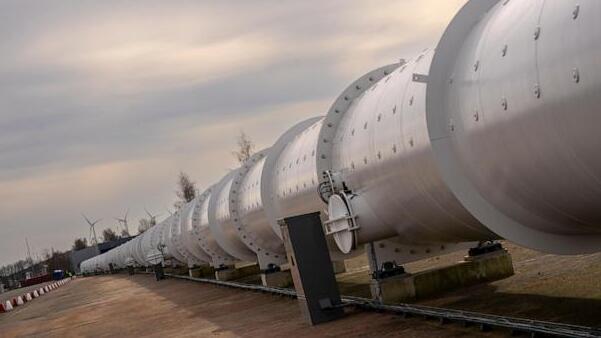A 420-meter (quarter-mile) white steel tube running alongside a railway line in the windswept northern Netherlands could usher in a new era in the transportation of people and freight.
The tube is the heart of the new European Hyperloop Center that opens Tuesday and will be a proving ground in coming years for developers of the evolving technology.
Hyperloop, once trumpeted by Elon Musk, involves capsules floating on magnetic fields zipping at speeds of arund 700 kph (435 mph) through low-pressure tubes. Its advocates tout it as far more efficient than short haul flights, high-speed rail and freight trucks.
But since Musk unveiled the concept that he said could shuttle passengers the nearly 400 miles (645 kilometers) between Los Angeles and San Francisco in 30 minutes, it has progressed at a much slower pace from the drawing board toward the real world.
“I expect by 2030 you will have the first hyperloop route, maybe five kilometers (three miles) in which people will actually be transporting passengers,” said the center’s director, Sascha Lamme. “Actually there’s already preparations being done for such routes in for example Italy or India.”
Not everybody is as optimistic about Hyperloop’s future.
“This is just another example of policy makers chasing a shiny object when basic investment in infrastructure is needed,” Robert Noland, distinguished professor at the Bloustein School of Planning and Public Policy at Rutgers University, said in comments emailed to The Associated Press.
“It costs too much to build,” he added.
Lamme said skeptics should come and take a look for themselves.
“We built the European Hyperloop Center and from what we have built, we know that we can be competitive with high-speed rail,” he said. “And then we have not even included all the cost optimizations that we can do in the coming decade to reduce that even further.”
The test center’s tube is made up of 34 separate sections mostly 2½ meters (more than eight feet) in diameter. A vacuum pump in a steel container next to the tube sucks out the air to reduce the internal pressure. That reduces drag and allows capsules to travel at such high speeds.
A test capsule built by Dutch hyperloop pioneer Hardt Hyperloop will take part next month in the first tests at the center that is funded by private investment as well as contributions from the provincial government, the Dutch national government and European Commission.
A unique feature of the Veendam tube is that it has a switch — where it splits into two separate tubes, a piece of infrastructure that will be critical to real-life applications.
“Lane switching is very important for hyperloop, because it allows vehicles to travel from any origin to any destination,” said Marinus van der Meijs, Hardt’s technology and engineering director. “So it really creates a network effect where you sort of have a highway of tubes and vehicles can take an on and offramp or they can take a lane switch to go to a different part of Europe or to a different destination.”
While testing continues in Veendam, hyperloop developers hope that destinations for their technology are forthcoming.
“Really the main challenge is finding government commitments to build routes and, on the other hand, finding new funding to realize the necessary test facility and technology demonstration that you need to do to make this happen,” Lamme said.
